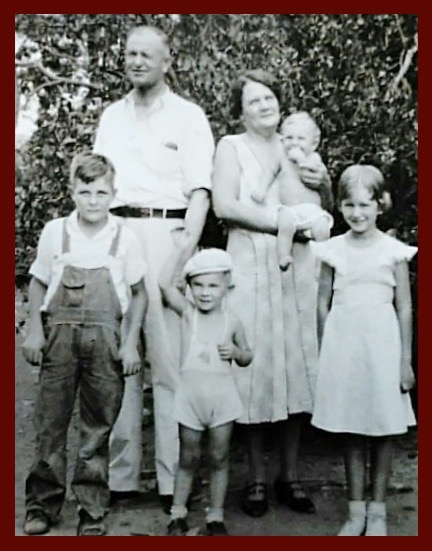
I was feeling pleased with myself over piecing together the time, place, date, and reason someone might have snapped a photo of Benjamin and Mary Stofer with their grandson Norman Stofer and three other children. Anyway, the year I finally settled on, and my explanation for it seemed at least plausible. Knowing that the families had left the vicinity of Lovewell by 1935, I concluded that the picture might be a memento of a get-together on the Stofer farm c. 1933, before relatives scattered and saw each other much less frequently.
Then, Norman's daughter Dale Ann emailed me to ask if I could identify the other kids in the photograph.
Fortunately, Ben and Mary Stofer had only three children, Bennie, Ethyle, and Pansy. The boy in overalls had been pointed out as Bennie’s boy, who seemed to be about seven or eight. I hesitated to guess about the others, not knowing for sure whether they were grandkids at all, perhaps only neighbors or playmates. All right, the baby caught up in Mary’s arms wasn’t someone she found on the porch that morning. He or she just about had to be a grandchild, and as for the other two, the tyke in the cap and sunsuit (who makes me think of Cousin Dill from To Kill a Mockingbird) clearly has Ben Stofer’s distinctive ears, while the little girl squints and smiles just like grandpa.
After drawing up a list of likely suspects, it occurred to me that if the picture was taken in 1934 rather than 1933, the names of Stofer grandchildren of appropriate ages line up nicely. The little girl would be Ethyle (Stofer) Dahl’s daughter Eleda, who was born the same year as her cousin Norman. Supposing that the tyke in the cap and sunsuit is three-year-old Douglas Larkins, elder son of Ben and Mary Stofer's daughter Pansy, then the baby could be Douglas's little brother Jean, born in December of 1933. Eleda would one day welcome a little brother named Dwayne, but not until 1935. I’d rather not admit that the picture could have been taken as late as 1936, since that would destroy my whole theory of what everyone was doing there.
What we manage to see in a piece of evidence sometimes depends on what we were looking for in the first place. Case in point - Mary Lovewell’s trip to Dodge City in February 1895 to visit her married sister Adaline. Knowing that Adaline died at 30, I first saw Mary’s journey to Dodge as a clue that her older sister had begun to experience chronic health problems at 22. Then, after learning a dark secret about Adaline’s husband, I wondered if Mary’s visit might instead have been her parents’ way of checking up on their wayward son-in-law.
Perhaps I was reading too much into a train ticket in the hand of a 14-year-old girl. Maybe Adaline was simply homesick, or Mary missed her big sister, or she was having a spat with her parents. Short of finding Mary’s diary, we may never know why she went to Dodge City in 1895. However, the fact that Mary told the Globe-Republican she had come to stay with her sister permanently, lets us know that whatever the reason was, it was a big deal, at least to Mary. She hadn’t simply decided to celebrate her graduation from the 8th grade with a sightseeing excursion.
It would be too much to hope that she took a camera.